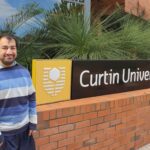Since Albert Einstein predicted the existence of black holes with his theory of relativity in 1916, humans have been fascinated with the enigmatic black hole.
A black hole is defined as a region of space from which gravity prevents anything, including light, from escaping.
Black holes still remain somewhat a mystery, which is why many scientists devote their lives to researching their existence. Curtin University alumnus and sessional academic Thomas Russell is one of them.
Thomas studies the connection between the infalling and outflowing matter around black holes. As a PhD candidate studying at the International centre for Radio Astronomy Research, which is a joint venture between Curtin University and The University of Western Australia and with support from an Australian Government Postgraduate Award and a Curtin research scholarship, he’s one step closer to uncovering how black holes develop and affect the universe.
Thomas says most people assume black holes are empty regions in space but there is actually more to them.
“Black holes are the most extraordinary objects in the Universe. They are incredibly mysterious and simple,” he says.

“They are not just one-way vacuum cleaners. Some of the infalling material is diverted into fast focused beams that shoot out, which are called jets,
“They cannot be seen as light falls into them but they have an incredible amount of mass (up to billions of times heavier than our sun) and the matter falling towards them releases huge amounts of energy, which means that their effect on the space around them can be observed and can tell us a lot about the black hole.”
Thomas investigates how black hole double star systems change over time by using state-of-the-art space and ground based telescopes in Australia, the U.S., Europe and Chile.
“My research reveals not only how the jets are formed and destroyed, but also, the mass of the black hole and the mass, size and nature of the star on which it is feeding on,” Thomas says.
“Which can be used to reveal how they may influence the evolution of galaxies and the Universe.”
https://www.youtube.com/watch?v=GqiPiErLsSw
Learn more about black holes.
His research also includes searching for massive black holes that are about 100,000 times the mass of our sun in galaxies, which provides insight into how the earliest galaxies evolved.
Thomas hopes his work can help to increase public awareness of how black holes affect the universe at large.
“What a scientist contributes to their field is only the tip of the iceberg to the impact they can have on the local community and the next generation of scientists,” he says.
“In the future I hope to continue to study black holes, either here or abroad, in the hope that I can help fill in the pieces about these objects and the universe”.



